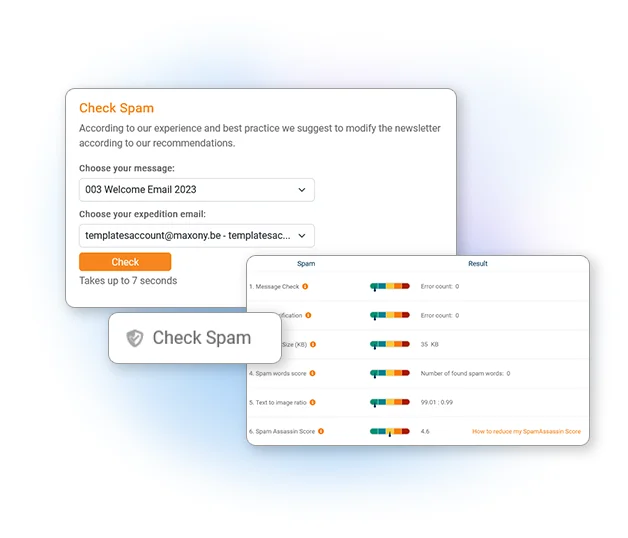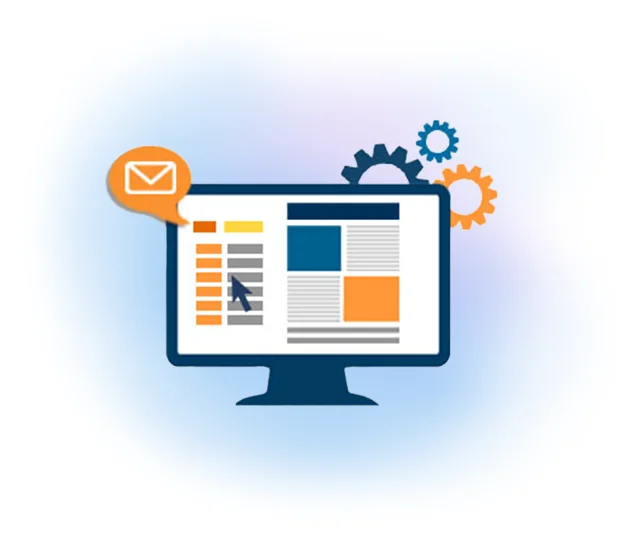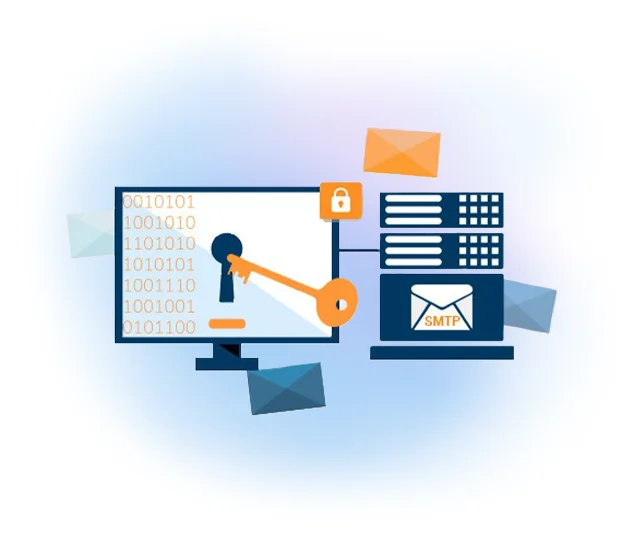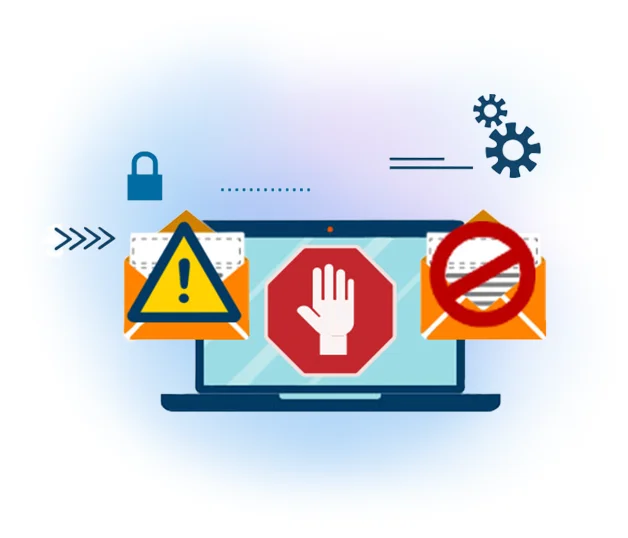Email Delivery Failure: 15 Common Reasons Why Your Delivery Fails
In today's digital age, email has become a cornerstone of communication for businesses, organizations, and individuals alike. Whether it's sending out newsletters, updates, or promotional offers, email is a vital tool for staying connected with customers, clients, and subscribers.
But what happens when your carefully crafted email doesn't reach its intended recipient? This is where the concept of email deliverability comes into play. Email deliverability refers to the ability of your email to successfully land in the recipient's inbox, rather than getting lost in the vast expanse of the internet or ending up in the dreaded spam folder.
Understanding the importance of email deliverability is crucial for anyone who relies on email as a means of communication or marketing. After all, what good is a well-crafted message if it never reaches its audience?
In this article, we'll take a closer look at the factors that can impact email deliverability and explore some common reasons why your email might fail to reach its destination. From spam filters to sender reputation, we'll cover it all in an easy-to-understand manner, so you can ensure that your messages are getting through loud and clear.
So, whether you're a seasoned email marketer or just getting started with email communications, join us as we delve into the fascinating world of email deliverability and discover how to avoid the pitfalls that can lead to delivery failure.
Invalid Email Addresses: The Lowdown
Let's talk about a common hiccup in the world of email: invalid email addresses. So, what exactly makes an email address invalid? Well, think of it like this: just as you need a complete and accurate address to send a letter through the mail, you need a properly formatted and active email address to send an email.
An invalid email address could be missing crucial elements like the "@" symbol or the domain name, or it might contain typos or extra spaces. Sending emails to these addresses is like trying to deliver a letter to a house that doesn't exist – it's just not gonna get there.
Now, you might be wondering, "What's the big deal if I send an email to an invalid address?" Well, aside from the fact that your message won't reach its intended recipient, it can actually hurt your email deliverability. Internet service providers (ISPs) and email servers keep an eye on things like bounce rates – that's when an email gets bounced back because the address is invalid. If your bounce rate is too high, it can signal to these providers that you're not taking proper care of your email list, which could land you in the spam folder faster than you can say "unsubscribe."
But fear not! Mailpro, for instance, offers solutions to help you manage and verify your email addresses. Tools like email verification services can check your list for invalid addresses and clean them up, ensuring that you're only sending emails to real, live inboxes. Plus, implementing double opt-inprocesses can help prevent typos and ensure that subscribers are entering their email addresses correctly.
So, the next time you're gearing up to hit send on that email campaign, take a moment to double-check your list and make sure you're not wasting your efforts on invalid addresses. Your deliverability – and your recipients' inboxes – will thank you for it!
Navigating the World of Spam Filters

Ever wonder why some of your emails end up in the spam folder instead of landing in your recipients' inboxes? That's where spam filters come into play. These little gatekeepers work tirelessly behind the scenes to sift through incoming emails and weed out the ones that look suspicious or spammy.
So, how exactly do spam filters work? Well, think of them as super-smart detectives with a knack for sniffing out anything fishy. They scan incoming emails for certain red flags, like suspicious links, excessive use of all-caps, or even certain keywords commonly associated with spam.
But here's the thing – sometimes even legitimate emails can get caught in the spam filter's crosshairs. That's why it's crucial to understand the common triggers for spam filters. Things like using misleading subject lines, sending emails from unfamiliar or unverified domains, or including too many images and not enough text can all raise a red flag for spam filters.
But fear not! There are ways to outsmart the spam filters and improve your email deliverability. Mailpro, for example, offers strategies to help you avoid getting caught in the spam folder. By following best practices like personalizingyour emails, providing clear and relevant content, and regularly cleaning your email list, you can increase the chances of your emails making it to the inbox instead of getting lost in spamland.
So, the next time you're crafting that perfect email campaign, keep these tips in mind and give your emails the best shot at reaching their intended recipients. After all, nobody likes getting stuck in the spam folder – not even your emails.
Understanding Sender Reputation

When it comes to email deliverability, your sender reputation is like your online reputation—it's what determines whether your emails end up in the inbox or get lost in the digital abyss. But what exactly is sender reputation, and why does it matter?
Think of sender reputation as your email street cred. It's a measure of how trustworthy and reputable you are as a sender in the eyes of email service providers (ESPs) and internet service providers (ISPs). A positive sender reputation can boost your chances of landing in the inbox, while a poor reputation can send your emails straight to the spam folder.
So, what factors influence sender reputation? Well, there are several key factors at play here. Things like your email engagement rates (think opens, clicks, and replies), spam complaints, and bounce rates all contribute to your overall reputation as a sender. The more engaged your recipients are with your emails and the fewer complaints and bounces you receive, the better your reputation will be.
But maintaining a positive sender reputation isn't just about avoiding the bad stuff—it's also about actively cultivating a good reputation. That means following best practices like sending relevant and valuable content, using double opt-in processes to verify subscribers, and regularly cleaning your email list to remove inactive or unengaged subscribers.
At Mailpro, we understand the importance of sender reputation, which is why we offer tools and resources to help you maintain a positive reputation and improve your email deliverability. From monitoring your engagement metrics to providing expert guidance on best practices, we're here to support you every step of the way.
So, remember, when it comes to email deliverability, your sender reputation matters. By following best practices and prioritizing engagement and trustworthiness, you can ensure that your emails not only reach the inbox but also resonate with your audience and drive results.
Understanding Blacklists
Ever heard of the email blacklist? It's like the naughty list for email senders – except instead of getting coal in your stocking, you might find your emails bouncing back or getting sent straight to the spam folder.
So, what exactly are blacklists, and how do they affect email deliverability? Well, think of blacklists as lists of known troublemakers in the email world. These lists are maintained by organizations like Spamhaus and SURBL, and they contain the domain names or IP addresses of senders who have been flagged for sending spam or engaging in other shady practices.
Being on a blacklist can seriously impact your email deliverability. Email servers and spam filters often consult these blacklists when deciding whether to accept or reject incoming emails. If your domain or IP is on a blacklist, there's a good chance that your emails will be rejected or marked as spam, even if you're sending legitimate messages to real recipients.
But fear not! There are ways to check if your domain or IP is on a blacklist. There are several online tools and services available that allow you to check the status of your domain or IP across multiple blacklists. These tools will give you a clear picture of whether you're on any blacklists and, if so, which ones.
So, what should you do if you find yourself on a blacklist? First, don't panic! Being on a blacklist isn't the end of the world, and there are steps you can take to get yourself removed. Start by identifying the cause of your listing – maybe you've been unknowingly sending spam, or perhaps your security measures need tightening. Once you've addressed the issue, you can reach out to the blacklist operator to request removal. It may take some time, but with patience and persistence, you can get yourself off the blacklist and back in the good graces of email servers everywhere.
At Mailpro, we understand the importance of maintaining a clean sender reputation, which is why we offer tools and resources to help you stay off the blacklist and ensure your emails reach their intended recipients. From monitoring your sender reputation to providing guidance on best practices, we're here to support you every step of the way.
So, next time you hit send on that email campaign, remember to keep an eye on your sender reputation and steer clear of the blacklist. Your deliverability – and your recipients' inboxes – will thank you for it!
Navigating Email Content Issues

When it comes to crafting the perfect email, content is king. But did you know that certain types of content can actually trigger email delivery failure? It's true! From spammy keywords to excessive use of images, there are a few content-related pitfalls that can trip up even the most well-intentioned email marketer.
So, what are some common types of content that can cause delivery issues? Well, for starters, anything that looks too much like spam is a big no-no. This includes things like using all-caps subject lines, excessive exclamation points, or deceptive language. Additionally, emails that are heavy on images and light on text can also raise red flags for spam filters.
But fear not! There are plenty of best practices you can follow to ensure that your email content is squeaky clean and delivery-friendly. For starters, make sure your subject lines are clear, concise, and relevant to the content of your email. Avoid using spammy keywords and phrases, and instead focus on providing value and engaging your recipients.
When it comes to the body of your email, aim for a good balance of text and images. Too many images can trigger spam filters, so be sure to include plenty of text to accompany your visuals. And always remember to include a plain-text version of your email for recipients who prefer to view emails without images enabled.
At Mailpro, we understand the importance of email content in ensuring delivery success, which is why we offer guidance and support to help you create content that resonates with your audience and avoids common delivery pitfalls. From email design best practices to tips for writing engaging copy, we're here to help you every step of the way.
So, the next time you're crafting that perfect email, keep these content tips in mind and give your emails the best chance of reaching their intended recipients. With a little care and attention to detail, you can ensure that your messages land in the inbox, not the spam folder.
Navigating Authentication Problems

Ever sent an email only to have it end up in the spam folder or, worse, bounce back undelivered? Authentication problems might be to blame. But fear not! With a little understanding of email authentication protocols and some troubleshooting know-how, you can overcome these hurdles and ensure your emails reach their intended recipients.
First things first, let's talk about the importance of email authentication protocols like SPF, DKIM, and DMARC. These protocols help verify that the sender of an email is who they claim to be, preventing spoofing and protecting against email fraud. Without proper authentication, your emails are more likely to be flagged as suspicious or spam, leading to delivery issues.
So, what are some common authentication problems you might encounter? One common issue is misconfigured authentication records, such as SPF or DKIM records that are missing or incorrect. Another problem is failing DMARC alignment checks, which can occur if your email headers are modified in transit.
But fear not! There are solutions to these authentication problems. For misconfigured records, the solution is to review and update your SPF, DKIM, and DMARC records to ensure they are correctly configured. This might involve working with your domain registrar or email service provider to make the necessary changes.
For failing DMARC alignment checks, the solution is to review your email authentication setup and ensure that your SPF, DKIM, and DMARC records are aligned properly. This might require adjusting your email authentication settings or working with your email service provider to troubleshoot the issue.
At Mailpro, we understand the importance of email authentication in ensuring delivery success, which is why we offer guidance and support to help you navigate authentication problems and ensure your emails reach their intended recipients. From reviewing your authentication records to providing troubleshooting assistance, we're here to help you every step of the way.
So, the next time you encounter authentication problems, don't panic! With the right knowledge and resources, you can overcome these hurdles and ensure your emails reach their destination, safe and sound.
Managing Your Sending Volume
Sending volume plays a crucial role in email deliverability. Send too many emails, and you risk overwhelming your recipients or triggering spam filters. Send too few, and you might miss out on valuable opportunities to connect with your audience. So, how do you strike the right balance? Let's dive in!
First off, let's talk about the impact of sending volume on email deliverability. Sending too many emails in a short period can signal to ISPs and spam filters that you're engaging in spammy behavior. This can result in your emails being flagged as spam or even blocked altogether. On the flip side, sending too few emails can lead to decreased engagement and lower deliverability rates.
So, what are some strategies for managing your sending volume to improve deliverability? One approach is to segment your email list based on factors like engagement level, interests, or demographics. By sending targeted, relevant emails to smaller segments of your list, you can avoid overwhelming your recipients and improve engagement rates.
Another strategy is to carefully monitor your sending frequency and adjust it based on recipient feedback and engagement metrics. Pay attention to metrics like open rates, click-through rates, and unsubscribe rates to gauge the effectiveness of your email campaigns and determine if you're sending too many or too few emails.
At Mailpro, we understand the importance of managing sending volume in maintaining good email deliverability, which is why we offer tools and resources to help you optimize your email sending practices. From segmentation and targeting features to analytics and reporting tools, we're here to support you in delivering the right message to the right people at the right time.
So, the next time you're planning an email campaign, take a moment to consider your sending volume and how it might impact your deliverability. By striking the right balance and sending emails strategically, you can improve engagement rates and ensure that your messages are reaching their intended recipients.
Finding Your Email Sending Sweet Spot
Sending frequency can make or break your email marketing efforts. Send too many emails, and you risk annoying your subscribers. Send too few, and you might miss out on valuable opportunities to connect with your audience. So, how do you strike the right balance? Let's explore!
First off, let's talk about the effects of sending emails too frequently or infrequently. Sending emails too often can overwhelm your subscribers and lead to email fatigue, causing them to tune out or even unsubscribe from your list. On the other hand, sending emails too infrequently can lead to decreased engagement and a loss of interest from your audience.
So, how do you find the optimal sending frequency for your audience? It all comes down to understanding your subscribers and their preferences. Pay attention to metrics like open rates, click-through rates, and unsubscribe rates to gauge how your audience is responding to your emails. Experiment with different sending frequencies and monitor the results to see what works best for your audience.
At Mailpro, we understand the importance of finding the right sending frequency to maximize engagement and deliverability, which is why we offer tools and resources to help you optimize your email sending practices. From schedulingfeatures to automation tools, we're here to support you in delivering the right message to your audience at the right time.
So, the next time you're planning an email campaign, take a moment to consider your sending frequency and how it might impact your audience. By finding the sweet spot that resonates with your subscribers, you can improve engagement rates and ensure that your messages are well-received.
Navigating Technical Issues in Email Delivery
Technical issues can sometimes throw a wrench in your email delivery efforts, but fear not! With a bit of know-how and the right tools, you can overcome these hurdles and ensure that your emails reach their intended recipients.
First, let's talk about some common technical issues that can lead to email delivery failure. One common issue is misconfigured DNS settings, such as missing or incorrect MX records or SPF/DKIM/DMARC records. Another issue is server blacklisting, which can occur if your server's IP address is associated with spam or suspicious activity.
Now, onto the solutions! For misconfigured DNS settings, the solution is to review and update your DNS records to ensure they are correctly configured. This might involve working with your domain registrar or hosting provider to make the necessary changes. Additionally, regularly monitoring your DNS settings and performing routine maintenance can help prevent issues from arising in the first place.
If your server has been blacklisted, don't panic! There are steps you can take to get yourself removed from the blacklist. Start by identifying the cause of the blacklisting and taking action to address it. This might involve investigating and resolving any security vulnerabilities on your server, implementing stricter email sending policies, or working with your hosting provider to request removal from the blacklist.
At Mailpro, we understand the importance of addressing technical issues in email delivery, which is why we offer guidance and support to help you navigate these challenges. From monitoring your DNS settings to providing assistance with blacklist removal, we're here to support you in ensuring that your emails reach their intended recipients.
So, the next time you encounter a technical issue in your email delivery efforts, remember to stay calm and focused. With the right knowledge and resources, you can overcome these hurdles and ensure that your emails are delivered successfully.
Decoding Bounce Rates in Email Delivery

Bounce rates – they're like the feedback mechanism of your email campaigns, telling you whether your messages are successfully reaching their destinations or encountering roadblocks along the way. Understanding bounce rates and knowing how to address them is key to maintaining good deliverability and keeping your email marketing efforts on track.
So, let's start with the basics: what exactly are bounce rates and why do they matter? Bounce rates refer to the percentage of emails that are returned to the sender because they couldn't be delivered to the recipient's inbox. High bounce rates can signal to email service providers (ESPs) that your email list might be outdated, improperly maintained, or even purchased from a questionable source, which can negatively impact your sender reputation and deliverability.
There are two main types of bounces: hard bounces and soft bounces. Hard bounces occur when an email is permanently rejected due to reasons like an invalid email address or a nonexistent domain. Soft bounces, on the other hand, are temporary issues that prevent an email from being delivered, such as a full mailbox or a server timeout.
So, how do you address bounce issues and improve your deliverability? Start by regularly monitoring your bounce rates and investigating any spikes or patterns that may indicate underlying issues with your email list or sending practices. For hard bounces, consider removing invalid or inactive email addresses from your list to prevent future delivery failures. For soft bounces, try resending the email after a short delay or reaching out to the recipient to confirm their email address or resolve any temporary issues.
At Mailpro, we understand the importance of managing bounce rates to maintain good deliverability, which is why we offer tools and resources to help you monitor and address bounce issues. From bounce management features to list hygiene best practices, we're here to support you in keeping your email campaigns running smoothly.
So, the next time you're analyzing your email performance metrics, pay close attention to your bounce rates and take proactive steps to address any issues that arise. By keeping your bounce rates in check, you can ensure that your emails are reaching their intended recipients and driving results for your business.
Navigating DNS Configuration Errors in Email Deliverability
DNS configuration might not sound like the most thrilling topic, but when it comes to email deliverability, it plays a crucial role. Understanding the importance of DNS configuration and knowing how to address common errors can make all the difference in ensuring that your emails reach their intended recipients.
So, let's start with the basics: why is DNS configuration important for email deliverability? Well, think of DNS as the internet's address book. It translates human-readable domain names (like example.com) into machine-readable IP addresses (like 192.0.2.1), allowing email servers to locate and deliver emails to the correct destination. Proper DNS configuration ensures that your emails are routed correctly and that your domain is authenticated, which can help improve deliverability and protect against spam and phishing attacks.
Now, onto the common DNS configuration errors. One common error is missing or incorrect MX (Mail Exchange) records, which specify the mail servers responsible for receiving email on behalf of your domain. Without proper MX records, email servers won't know where to deliver your emails, leading to delivery failures. Another error is misconfigured SPF (Sender Policy Framework) or DKIM (DomainKeys Identified Mail) records, which help verify the authenticity of your emails and protect against spoofing and phishing attacks.
So, how do you fix these DNS configuration errors? Start by reviewing and updating your DNS records to ensure they are correctly configured. This might involve working with your domain registrar or hosting provider to make the necessary changes. Additionally, regularly monitoring your DNS settings and performing routine maintenance can help prevent issues from arising in the first place.
At Mailpro, we understand the importance of proper DNS configuration in ensuring email deliverability, which is why we offer guidance and support to help you navigate DNS configuration errors. From DNS management tools to expert advice on best practices, we're here to support you in maintaining a healthy DNS setup and maximizing your email deliverability.
So, the next time you're troubleshooting email delivery issues, don't forget to check your DNS configuration. By addressing common errors and keeping your DNS settings up to date, you can ensure that your emails reach their intended recipients and drive results for your business.
Mastering Inbox Placement and Email Deliverability
Ever wonder why some emails end up in the inbox while others get lost in the dreaded spam folder? It all comes down to inbox placement – the holy grail of email deliverability. Understanding the factors that affect inbox placement and knowing how to improve your placement rates can make all the difference in the success of your email campaigns.
So, let's dive into the factors affecting inbox placement and email deliverability. One key factor is your sender reputation – the trustworthiness and reliability of your sending domain and IP address. ISPs and email service providers (ESPs) use sender reputation metrics to determine whether your emails should land in the inbox or be relegated to the spam folder. Factors like engagement rates, spam complaints, and bounce rates all contribute to your sender reputation and, consequently, your inbox placement.
Another factor is email content and engagement. ISPs analyze factors like open rates, click-through rates, and user interactions with your emails to determine their relevance and value to recipients. Emails that are engaging, relevant, and personalized are more likely to land in the inbox, while generic or spammy emails are more likely to be flagged as spam.
So, how do you improve your inbox placement rates? Start by focusing on building and maintaining a positive sender reputation. This means sending relevant, valuable content to engaged subscribers, regularly cleaning your email list to remove inactive or unengaged contacts, and following best practices for email authentication and deliverability.
Additionally, pay attention to your email content and engagement metrics. Test different subject lines, sender names, and content formats to see what resonates best with your audience, and use analytics to track the performance of your emails over time. By continuously optimizing your email campaigns based on data and feedback, you can improve your inbox placement rates and drive better results for your business.
At Mailpro, we understand the importance of inbox placement in email deliverability, which is why we offer tools and resources to help you maximize your inbox placement rates. From deliverability monitoring to engagement tracking, we're here to support you in getting your emails where they belong – right in the inbox.
So, the next time you're planning an email campaign, remember to keep these strategies in mind and give your emails the best chance of reaching their intended recipients. With the right approach, you can improve your inbox placement rates and drive success for your business.
Boosting Subscriber Engagement for Stellar Deliverability

Subscriber engagement isn't just a buzzword – it's the secret sauce to email deliverability success. When your subscribers are actively engaging with your emails, it sends positive signals to ISPs and email service providers, boosting your sender reputation and increasing the likelihood that your emails will land in the coveted inbox. Let's explore why subscriber engagement matters and how you can supercharge it to improve your email deliverability.
First things first, let's talk about why subscriber engagement is so important for email deliverability. ISPs and email service providers closely monitor engagement metrics like open rates, click-through rates, and reply rates to determine the relevance and value of your emails to recipients. High engagement signals that your emails are wanted and appreciated by your audience, while low engagement can indicate that your emails are unwanted or irrelevant, leading to decreased deliverability rates.
So, how do you boost subscriber engagement and improve your deliverability? It all starts with delivering content that resonates with your audience. Personalize your emails, segment your lists, and send targeted, relevant content that speaks to the interests and needs of your subscribers. Use catchy subject lines, compelling calls to action, and eye-catching visuals to grab your subscribers' attention and encourage them to engage with your emails.
But engagement goes beyond just opens and clicks – it's also about fostering meaningful interactions and building relationships with your subscribers. Encourage feedback, respond promptly to inquiries and complaints, and make it easy for subscribers to interact with your emails and take action. By nurturing these relationships and providing value to your subscribers, you can strengthen engagement and improve your email deliverability over time.
Mastering List Hygiene for Optimal Deliverability
Maintaining a clean email list isn't just a best practice – it's essential for ensuring that your emails reach their intended recipients and driving better results for your business. Let's explore why list hygiene matters and how you can keep your email list in tip-top shape to improve your deliverability.
First off, why is list hygiene so important? Well, think of your email list as a garden. Just like you wouldn't want weeds choking out your beautiful flowers, you don't want inactive or unengaged subscribers clogging up your email list. These subscribers can drag down your engagement rates, increase your spam complaints, and damage your sender reputation, leading to decreased deliverability and effectiveness of your email campaigns.
So, what are some best practices for list hygiene to improve your deliverability? Start by regularly cleaning your email list to remove inactive or unengaged subscribers. Segment your list based on engagement metrics like opens and clicks, and target your re-engagement efforts towards subscribers who haven't interacted with your emails in a while. Consider implementing a double opt-in process for new subscribers to ensure that your list remains clean and engaged over time.
Additionally, pay attention to bounce rates and spam complaints, and take prompt action to address any issues that arise. Remove invalid or undeliverable email addresses from your list, and promptly unsubscribe recipients who request it. By proactively managing your email list and keeping it clean and engaged, you can improve your deliverability rates and drive better results for your business.
At Mailpro, we understand the importance of list hygiene in email deliverability, which is why we offer tools and resources to help you maintain a clean and engaged email list. From segmentation and targeting features to bounce management and re-engagement tools, we're here to support you in maximizing the effectiveness of your email campaigns.
So, the next time you're planning an email campaign, take a moment to review your email list and ensure that it's clean, engaged, and ready to deliver results. By prioritizing list hygiene, you can improve your deliverability rates and drive success for your business.
Addressing Email Service Provider (ESP) Issues
Email service providers (ESPs) are like the backbone of your email marketing efforts – they provide the infrastructure and tools you need to send, track, and manage your email campaigns. But what happens when you encounter problems with your ESP that impact your deliverability? Let's take a closer look at some common ESP issues and steps you can take to address them.
First off, what are some common issues that can arise with ESPs and impact deliverability? One common issue is deliverability fluctuations, where your emails suddenly start landing in the spam folder or experiencing higher bounce rates. This can be caused by changes in your ESP's sending infrastructure, changes to their deliverability policies, or even technical issues on their end.
Another issue is deliverability support and guidance. Some ESPs may not offer the level of deliverability support and guidance that you need to navigate complex deliverability challenges. This can leave you feeling stranded and unsure of how to address issues like inbox placement, spam complaints, or bounce rates.
So, what steps can you take if you encounter problems with your ESP that impact your deliverability? Start by reaching out to your ESP's support team to report the issue and request assistance. Provide as much detail as possible about the problem you're experiencing, including any relevant metrics or data, and work closely with your ESP to troubleshoot and resolve the issue.
If you're not satisfied with the level of support you're receiving from your ESP, consider exploring other options. Look for an ESP that offers robust deliverability support and guidance, including proactive monitoring, deliverability consulting, and troubleshooting assistance. By partnering with an ESP that prioritizes deliverability, you can ensure that your email campaigns are set up for success.
At Mailpro, we understand the importance of reliable ESP support in ensuring email deliverability, which is why we offer dedicated deliverability support and guidance to help you navigate any challenges that arise. From proactive monitoring to expert advice and assistance, we're here to support you in maximizing the effectiveness of your email campaigns.
So, the next time you encounter problems with your ESP that impact your deliverability, don't panic! Take proactive steps to address the issue and consider exploring other options if necessary. With the right support and guidance, you can ensure that your email campaigns reach their intended recipients and drive results for your business.
Conclusion: Elevate Your Email Deliverability Game
In the fast-paced world of email marketing, mastering deliverability is essential for success. From navigating technical challenges to engaging subscribers and maintaining a clean email list, every aspect of your email strategy plays a crucial role in ensuring that your messages reach their intended recipients and drive results for your business.
Throughout this comprehensive guide, we've explored the key factors that impact email deliverability and provided actionable strategies for overcoming common hurdles. Whether it's optimizing your DNS configuration, boosting subscriber engagement, or addressing issues with your email service provider, we've covered it all.
At Mailpro, we understand the importance of email deliverability in achieving your marketing goals, which is why we offer tools and resources to help you navigate these challenges and maximize the effectiveness of your email campaigns. From deliverability monitoring to engagement tracking and list hygiene best practices, we're here to support you every step of the way.
So, the next time you're planning an email campaign, remember the lessons learned in this guide and take proactive steps to optimize your deliverability. By prioritizing best practices, staying vigilant against common pitfalls, and leveraging the right tools and resources, you can ensure that your emails stand the best chance of reaching the inbox and driving results for your business.
Thank you for joining us on this journey to elevate your email deliverability game. Here's to delivering success, one email at a time.
